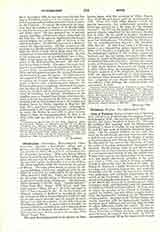

Ottobeuren (OTTOBURA, MONASTERIUM OTTOBURANUM), formerly a Benedictine abbey, now a priory, near Memmingen in the Bavarian Allgäu. It was founded in 764 by Blessed Toto, and dedicated to St. Alexander, the martyr. Of its early history little is known beyond the fact that Toto, its first abbot, died about 815 and that St. Ulric was its abbot in 972. In the eleventh century its discipline was on the decline, till Abbot Adalhalm (1082-94) introduced the reform of Hirsau. The same abbot began to restore the decaying buildings, which were completed, with the addition of a convent for noble ladies, by his successor, Abbot Rupert I (1102-45). Under the rule of the latter the newly founded abbey of Marienberg was recruited with monks from Ottobeuren. His successor, Abbot Isengrim (1145-80), wrote “Annales minores” (Mon. Germ. Hist.: Script., XVII, 315 sq.) and “Annales majores” (ibid., 312 sq.). In 1153, and again in 1217, it was consumed by fire. In the fourteenth and fifteenth centuries it declined so completely that at the accession of Abbot Johann Schedler (1416-43) only six or eight monks were left, and its annual revenues did not exceed 46 silver marks. Under Abbot Leonard Wiedemann (1508-46) it again began to flourish: he erected a printing establishment and a common house of studies for the Suabian Benedictines. The latter, however, was soon closed, owing to the ravages of the Thirty Years’ War.
The most flourishing period in the history of Ottobeuren began with the accession of Abbot Rupert Ness (1710-40) and lasted until its secularization in 1802. From 1711-1725 Abbot Rupert erected the present monastery, the architectural grandeur of which has merited for it the name of “the Suabian Escorial“. In 1737 he also began the building of the present church, completed by his successor, Anselm Erb, in 1766. In the zenith of its glory Ottobeuren fell a prey to the greediness of the Bavarian Government (see Schleglmann, “Geschichte der Säkularisation im rechtsrheinischen Bayern”, III, Ratisbon, 1906, 611-54). In 1834 King Louis I of Bavaria restored it as a Benedictine priory, dependent on the abbey of St. Stephen at Augsburg. At present (1910) the community consists of five fathers, sixteen lay brothers, and one lay novice, who have under their charge the parish of Ottobeuren, a district school, and an industrial school for poor boys. Noteworthy among monks of Ottobeuren are: Nicolas Ellenbog, humanist, d. 1543; Jacob Molitor, the learned and saintly prior, d. 1675; Albert Krey, the hagiographer, d. 1713; Fr. Schmier, canonist, d. 1728; Augustine Bayrhamer, d. 1782, and Maurus Feyerabend, d. 1818, historians; the learned Abbot Honoratus Goehl (1767-1802), who was a promoter of true church music, and founded two schools; Ulric Schiegg, the mathematician and astronomer, d. 1810.
MICHAEL OTT

